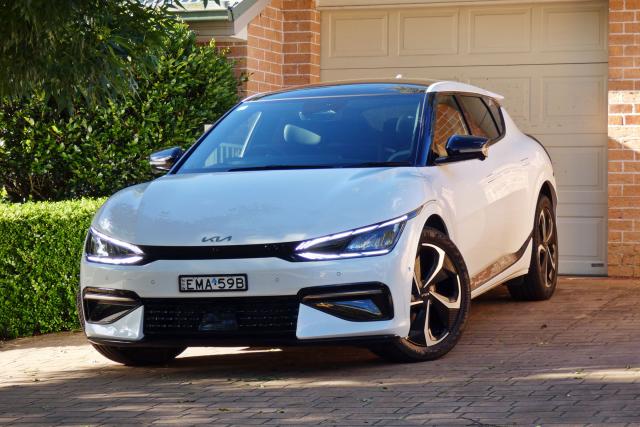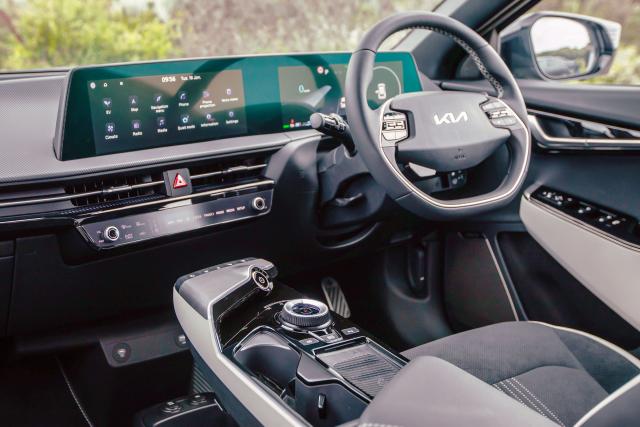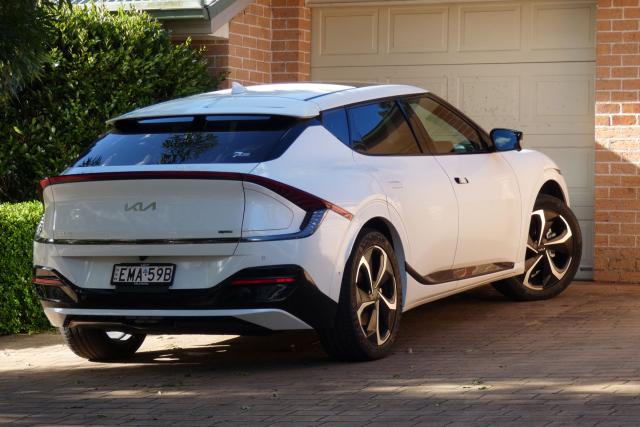Part II…
ENGINES / TRANSMISSIONS
Air is the more range focused of the trio, with 168kW of power and 350Nm of torque and a range of 528km, while RWD GT-Line with the same powertrain is good for 504km.
GT-Line with AWD adds a second electric motor and produces a combined output of 239kW and 605Nm, along with a range of 484km.
All are powered by the same 77.4kWh battery pack, which is located under the floor and weighs 477kg, with a single speed reduction gear transmission.
Moving through the grades, energy consumption ranges from 16.5 to 17.2 to 18.0 kWh/100km.
SAFETY
Five-star safety starts with seven airbags, a rear-view camera with dynamic guidelines, plus Autonomous Emergency Braking (AEB) with car, pedestrian, cyclist detection (and junction turn assist).
There’s also Blind Spot (including rear cross traffic assist), Intelligent Speed Limit Assist (ISLA), Lane Follow Assist (LFA), Lane Keep Assist (LKA), Driver Attention Warning with lead vehicle departure alert (DAW+), Multi-Collision Braking (MCB) and Tyre Pressure Monitoring System (TPMS).
EV6 provides three top tether and two ISOFIX child seat anchors.
DRIVING
There are four selectable drive modes: Eco, Normal, Sport and Snow which also change the look of the instruments.
Adding some drama to the drive experience is Active Sound Design (ASD) with a choice of artificial engine sounds and custom setting.
They’re unique electronica rather than engine noise emulations.
With this much power and torque under foot and all that torque available in a flash, EV6 has plenty of get up and go, with 0-100km/h in the AWD taking a rapid 5.2 seconds.
With a burst of speed, overtaking can be accomplished virtually at will, but it’s a weighty device and wants to run wide in corners. Steering is heavy and uncommunicative.
EV6 has powerful braking too, perhaps too strong at times, or more specifically — irritatingly abrupt. It pulls up with a jerk and releases with a lurch, and can be difficult to control in close manoeuvring.
One way to avoid this happening is one-pedal driving, using the regenerative brake system that is controlled by the steering wheel paddles normally devoted to gears.
In this way, the car slows when you lift off the accelerator — to a complete stop if necessary.
An electric parking brake is provided, but instead of being located close to hand in the centre console, it’s relegated to a position to the right and below the dash.
More jerkiness follows. Try releasing the brake and moving off in reverse if you’re parked on a slope. A dab on the accelerator pedal is required and is liable to result in an intake of breath as the car shoots backwards.
EV6’s space-age look is polarising. Some people love it, others hate it.
Facing the wrong direction, the pop-out handles are awkward to use and for a 4.7 metre vehicle getting in and out is not as easy as it should be.
The door openings are large, but a low roofline and relatively high seating position compromise access, together with the sunroof that further reduces headroom. Watch your head and hold on to your sunglasses.
Ditto for rear seat passengers, with an elevated seating position and low hanging roof, and surprisingly little legroom considering the length of the car.
Getting into the car for the first time I was confronted with a washed-out instrument panel with pale blue lettering on a white background that was difficult to see in sunlight.
I was later able to change this to black after finding the appropriate setting in the infotainment system, but for the first few minutes I was flying blind.
Moving from one Kia to another, the steering wheel switch gear is familiar, but they had been transposed from one side of the wheel to the other.
The dash layout is similar to that of the Niro EV that we drove, but as with Niro I found that I had lost a physical volume control.
The luggage area is quite large with a hidden area underneath for cable storage, along with a smaller boot at the front of the car, but alas no spare tyre.
A tyre repair kit is provided instead. Oh, and in case you’re wondering, it can tow a 1600kg load.
Most annoying was the location of the charge port. In Niro it is sensibly located at the front, but in EV6 it is cleverly concealed near the driver side tail light. The location necessitates backing the car in to access power.
Charging can take a looong time with a standard powerpoint, down to as little as 18 minutes for 80 per cent with a 350kW DC commercial charger.
Even fully charged the system reported a distance to empty range of 412km — some 70km less than claimed.
Stranger still, after travelling a few kilometres to do some shopping, the range actually went up a few kilometres rather than down, even though the battery dropped to 97 per cent.
At the end of the day, we were getting 17.0kWh/100km after about 400km of mixed driving.
After all the EV6 hype, it’s a mixed bag and something of a let-down.
Until now Kia’s ergonomics have been a shining example of simplicity. Who let the nerds out?
SUMMING UP
It’s a halo model for the brand, pure and simple. Cashed up nerds will want one. Lesser so, user-choosers, who will be drawn to the usual line-up of Euro suspects.
Who then does that leave? It’s a fairly short, exclusive list at $90K by the time you put it on the road.
Just over 500 EV6s have found homes in Australia this year. Over the same period, Kia has sold four times as many Stingers (and they reckon its days are numbered).
No doubt, the arrival of the EV6 GT will give the figures a bit of a bump — but after that, who knows?









